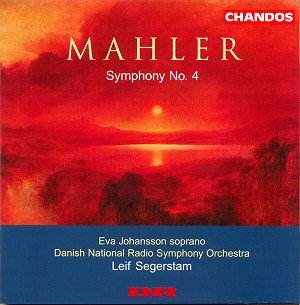Gustav MAHLER
Symphony No.4 in G
Major
 Eva Johansson
(Soprano)
Eva Johansson
(Soprano)
Danish Radio Symphony Orchestra
Conducted by Leif Segerstam
 Chandos CHAN 9836
[61:42]
Chandos CHAN 9836
[61:42]
Crotchet

In Mahler's Fourth Symphony there is no great wrestling with questions of
existence as there is in the previous two. Hardly any concern either with
conflict and resolution as in the succeeding three. The Fourth is often seen
as Mahler's least troubled symphony. Since it's also his shortest and the
one with the prettiest, most tuneful textures, it's also his most popular
and approachable. However be careful about viewing it as entirely untroubled.
There are dark shades on these textures and a delicate interplay of emotion
and for the conductor this all means a careful balancing act. Accentuate
those dark elements, pile the work with too much emotional drag and the fairy
tale nature is lost. Play down the shadows, take too far a step back and
the bogeymen peeping out from behind the drapes disappear from view. Segerstam
tends towards the former category and this is in keeping with his approach
to Mahler generally which always tends to the dramatic, the romantic and,
in some cases, the mannered. Maybe it's the special nature of the Fourth
but not even Segerstam, some of whose Mahlerian excesses I have found
unacceptable, can spoil the work and prevent him delivering a recording with
much appeal, though it could not be called "mainstream" like those by Kletzki,
Szell, Horenstein or Kubelik are. Segerstam falls more into the kind of
subjective interpretation represented by Mengelberg or Barbirolli but with
the extra advantage of superb playing and recording, even though the latter
may strike some as being too large-scale to suit what is a more intimate
work.
The slow third movement is best representative of the kind of interpretation
Segerstam seems to be offering. The approach is deeply expressive and the
effect deeply tragic: worlds away from the Schubert-like poise of Boulez
on DG or the ice- crystal purity of Reiner on RCA, for example. In fact I
think Segerstam looks to what would for Mahler be more recent times as he
puts me in mind of the hot house atmosphere of Wagner's Wesendonk Lieder
with its dark colours and long, sensuous lines. Never was Beecham's remark
about this work of Mahler's as "the illigeitimate offspring of Tristan and
Isolde" more apt.
We should have been alerted to the approach Segerstam would adopt in the
third movement from his account of the second. His "hands-on" approach allows
him to accentuate weirdness in the Trios that ought to have more parody about
them. He probably takes this movement too much at face value where Mahler
has something subtler in mind - a cartoon world of fairy tale fears
in his portrayal of "Friend Death" striking up on his out-of-tune fiddle.
Certainly this is culture shock after Horenstein and Kletzki, who all seem
more in tune with Mahler's cheekiness and self-mocking. In the first movement
Segerstam also invests every bar with special attention and this brings some
nice touches, like the lower woodwind chuckling away in the Development.
But some may find his close attention to detail here ultimately gets in the
way of the broader flow. It only remains to report that Eva Johansson is
a rather anonymous soprano in the last movement though Segerstam's accompaniment
of her is exemplary.
An expressive, consciously moulded performance resonantly recorded and sonorously
played. Some of Mahler's lightness of touch is sacrificed but Segerstam's
involvement offers a persuasive alternative to more central views.
Reviewer
Tony Duggan
Performance:

Recording:

